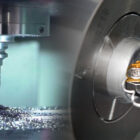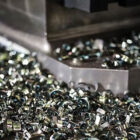When it comes to machining, accuracy is paramount. Reaching tight tolerances is crucial, whether you’re making complex parts for the aerospace industry, engine blocks with accurate bores, or essential parts for medical devices. This quest of precision heavily relies on the boring head, a multipurpose and indispensable tool used in machining processes. Let’s understand how the boring head helps achieve precision by reducing chatter and vibration, maximizing cutting parameters, and emphasizing the value of coolant and lubrication.
Reducing chatter and vibration
Tool selection
One of the most important things in reducing chatter and vibration is the selection of the boring tool. Tools can improve stability and lessen their tendency to vibrate by using the proper geometry, material, and coatings. Toolholders with anti-vibration properties may also be useful.
Rigidity of the setup
The setup must be robust in order to reduce vibrations. Verify that the machine is in good working condition, the workpiece is secured firmly, and that the toolholder is sturdy.
Cutting speed and feed rate
Make the necessary adjustments to the feed rate and cutting speed. Overfeeds or speeds can generate vibrations, and too slow of a cut might make the tool rub instead of cutting.
Depth of cut
Don’t overcut or chatter the tool; instead, keep the depth of cut to a level that the machine and tool can manage.
Dampening
You can lessen vibrations by dampening the boring bar. Bar-style toolholders are one type of damping device that can be used; they are made to reduce vibrations and improve stability.
Tool overhang
Vibrations are less likely to occur with shorter tool overhangs. Selecting tools with less overhang can help to lessen the leverage that can exacerbate vibrations.
Maximizing cutting parameters
Optimizing cutting parameters is another necessary step towards achieving precision with a boring head. The depth of cut, feed rate, and cutting speed are some of these variables. Here’s how to configure them for the best results.
Cutting speed
The rate at which the workpiece is sliced by the tool’s cutting edge is known as the cutting speed. The material being machined determines the appropriate cutting speed. To determine the right speed, refer to cutting speed tables or the instructions provided by the tool manufacturer.
Feed rate
The tool’s advancement into the workpiece is governed by the feed rate. The feed rate ought to remove material effectively without overly wearing out the tool or vibrating it.
Cut depth
The distance the tool travels through the workpiece in a single pass is known as the depth of cut. It affects the tool’s cutting forces and the rate at which material is removed. The ideal depths of cut differ based on the machine, tool, and material. Beginning at cautious depths, modify them in accordance with the workpiece’s composition and the machine’s performance.
Emphasizing the value of coolant and lubrication
For precise boring head machining, efficient coolant and lubrication techniques are essential as they serve multiple purposes.
Temperature control
Overheating can cause workpiece distortion, tool wear, and decreased precision. This is where the coolant assists in regulating the heat produced during machining.
Chip evacuation
The coolant helps remove chips from the area where they are cut. This efficient removal of chips reduces tool wear and avoids recutting.
Lubrication
By lowering friction between the tool and the workpiece, lubrication can improve surface smoothness and prolong the life of the tool.
Type of cutting fluid
Depending on the material being machined, a different type of cutting fluid is employed. While oil-based fluids are typically selected for more difficult applications, water-based coolants are appropriate for a variety of materials.
Delivery method
The coolant delivery mechanism is very crucial. While through-tool coolant systems supply coolant directly to the cutting edge, improving cooling and chip evacuation, flood coolant systems maintain a steady flow of coolant over the cutting zone.
The skill of using a boring head to achieve precision involves a combination of tool selection, cutting parameter optimization, and efficient coolant and lubrication. This means that only selecting the best quality boring heads from reputed precision boring head manufacturers in Bangalore, one like FineTech Toolings, isn’t enough. While it is a wise decision to buy high quality products, it is also essential that the art of precision machining is mastered by adhering to the aforementioned rules, which will enable to make components with tight tolerances and outstanding surface finishes.






